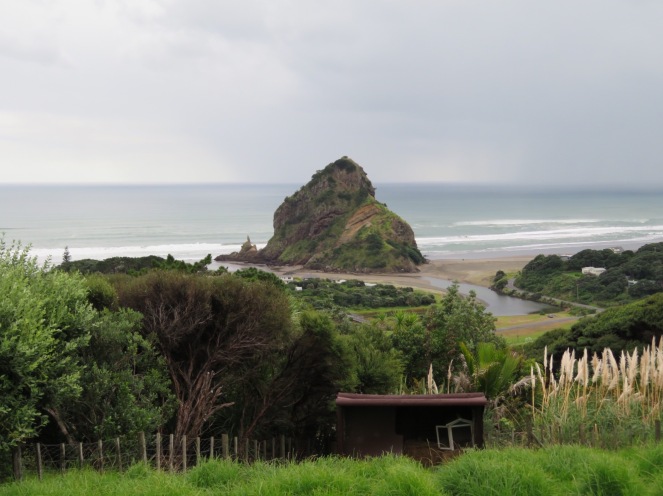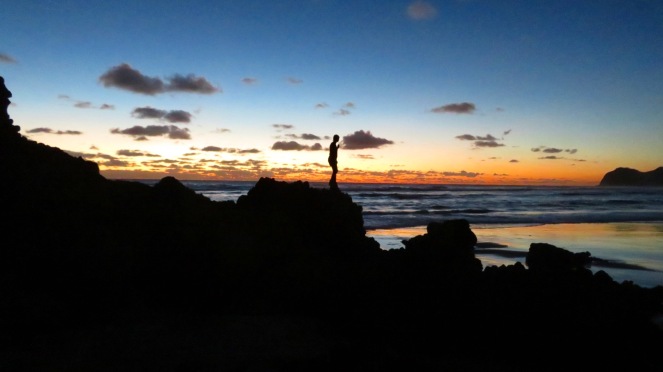We slept in our van for the first time in the parking lot of Piha Beach. By the time we arrived, the sun was liquefied copper on the horizon, pooling on the waves, turning the black volcanic sand to rose gold. The white cliffs glowed as if they were hot to the touch. Lion Rock stood like a mammoth sentry in the middle of the beach, an old god furred with trees. After the sun dipped into the ocean, the sound of the waves threaded through our windows.
Piha is known not only as one of the best surf beaches in New Zealand, but also one of the most dangerous. If you view the tides in slow motion, they don’t just ebb and flow; they rotate between the cliffs, the rip currents sinuous and circular. Piha is also one of the most beautiful beaches in the North Island; its wild beauty lies not only in its green water and dark sand, but in its immense bluffs, jagged volcanic rocks, and the relentless ferocity of its surf.
We were wwoofing for the week at Piha Surf; Pam and Mike ran a combination of surfing school, private farm, and former backpacker accommodation on their 7-acre property just above the beach. From the porch you could see the waves crashing on Piha Beach, the dark hunkered shape of Lion Rock. The surf shop attached to their house was filled with the gleam of Mike’s custom surfboards. All day we would hear the buzz of his sander from his workshop; Mike heavyset in a tank and shorts, a white protective mask over his lined face, his hands white with dust as he shaped the grooves of the board. Dust filmed over the ancient boombox tuned to Piha’s only radio station.

Pam had decided that managing a backpacker accommodation was too time-consuming as she and Mike drew close to retirement age, so now she just oversaw the wwoofers who helped maintain their property: Lauren and I, a teenage American named Eliza, and Leo from Sweden.
“There’s an arsonist at large,” she informed us over morning tea. He had been setting fires to the sea cliffs, one right after the other, too quick to catch. He’d also burned down an iconic cafe on the beach. We saw it later: The blackened bricks and collapsed wall, the charred remains of counter and chairs, soda bottles grey and warped in a scorched vending machine with no glass.
“I’ll bet he comes from a broken home. No father figure, that sort of thing. Drugs and alcohol.” Pam stirred sugar into her tea. “We never used to lock our gate, but now we have to. You never know what some people will do.”
***
Wwoofing at Piha Surf was like stepping back in time to the 1960s or 70s. We slept in converted camper caravans, trailers rusted and tires deflated, typically with an uninsulated room built on. With no running water and a heater that barely worked, we slept under piled afghans and brushed our teeth in a bucket-basin outside, but the place was clean and freshly painted. The toilets were wooden outhouses, aka “bush dunnies,” with hand sanitizer provided in discarded juice bottles. We cooked in a communal cookhouse, separating scraps into compost and recycling, washing the dishes in cold rainwater from the tap, drinking water provided by Pam in recycled jugs.
Everything was saved, jerririgged for some purpose.The shower was rigged to a propane tank, two car batteries, and a lightswitch. If it started sputtering, you had to switch the jumper cables from one battery to the other.
But Pam was meticulously clean: fresh paint, tidy organization, and bright flowers made the property look less scrapyard and more eclectic, funky, and charming.
We worked from 9:00 am to 12:30 pm, with a break for tea at 10:30. We helped cut flax, pull weeds, pick up dead palm fronds leaves–”Cleaning up nature’s rubbish,” Pam said. We painted the aluminum shed roof and the caravans a warmth-absorbing black for winter, washed the cars, scrubbed the porch, organized the shed.
The afternoons were ours, and they were slow and easy. Leo practiced juggling. Eliza surfed. Lauren tried out a few tunes on a red ukulele left behind by a previous wwoofer. I read a battered copy of Dune I found in our caravan. Every song that came on the radio station was several decades old.
“He’s calling in fake fires now. He just likes to see people scramble.” Pam pursed her lips over her tea. Small and dynamic, she had paint on her callused hands from working alongside us. “A real strain on our community fire department. Just volunteers. They slog up the mountain at all hours, and there’s nothing there. Thank god–but still.” She’d seen a strange man driving slowly in a white van down the hillside, looking up at the houses. She’d called in his license plate–just in case.
Twice that week, we heard the siren from the beach at dusk. I walked to the edge of the house, eyes on the blue horizon, Pam silhouetted silently on the porch. No scent of smoke, no glow of fire. Just the wind sliding through the palm fronds, and the wailing in the gathering dark.

***
There are tons of great hikes in the Karekare region, but we stuck close to the beach. After lunch one day, Leo, Eliza, Lauren and I hiked to Kitekite falls, Pam’s old, overweight golden retriever Roxie leading the way. Icy water tumbled over a tiered cliff face several stories high into a deep blue pool at the base, thick with rainforest greenery even well into autumn. At the top, a series of smaller falls rushed into deep, clear pools gouged into the volcanic rock.

A blue pool was sunk into the very edge of the larger falls. I couldn’t resist; it was neither warm nor sunny, but I stripped to my bra and shorts and plunged in. The water was gaspingly cold, the kind of shock that made you feel the electric life in every inch of your body, and leaves you feeling strangely warm after you clamber out. I rested on the lip of the falls, sucking in the air the cold stole from my lungs, the land folded open in front of me as the water sliced over the edge of the pool.
Another day, another lazy afternoon, I walked alone down a half-hidden staircase that zigzagged from the road, through the bush, to the beach. I followed the curve of sand, still dark from high tide, between the mammoth sea cliffs until I came to the base of Camel Rock. I began to climb over its steeply ascending humps, first over wet rock sharp with sealed mussels, then through a tightly winding footpath nearly obscured by flax and scrub–more indentation than trail.
The waves chewed the base of the cliffs, thrashing and frosty with foam. The land fell away, becoming bathed in shadow as the sun dipped toward the horizon.
A dark burn stained the length of an entire bluff to my right, the grass blackened–the arsonist’s handiwork. I stared, then continued wading through the scrub, imagining the heat and the stench, a faceless figure with a gas can and a match, someone who liked to watch the trees wither and the people scramble, hungry like the sea.
Camel Rock curved into the ocean, and as I climbed, the thick bush fell from my waist to my ankles and, finally, gave way under my boots to a rocky outcropping balanced precariously above the beach, hundreds of feet above the crashing surf. The houses were very far away now, Lion Rock small and crouching. A couple people had already made the climb and dangled their legs off the edge, drinking in the last light of the sun.
I balanced on the slim cliff’s edge between land and sea, wondering if this is how it felt to be on top of the world. My one dream had been to point my shoes in any direction I chose, and go there. And now, we were doing it.

***
“They caught him,” Pam announced at tea. “Only 19, one of Piha’s own. A star surfer, would you believe it? Top marks at school. No sign of trouble before now. I said broken home; I couldn’t have been farther off. Respectable family, we’ve all known them for years: his mum’s an editor for the local paper, and his dad’s got a good job on the Auckland Council.”
“His family is ruined,” she told us over buttered bread. “He’s going to prison for sure. Terrible business. They’ll probably have to move.”
Why had he done it? Nobody could say.
Our easy days at Piha were coming to an end; Leo and Eliza were returning home, their respective travels finished, Lauren and I were moving on, and Pam was closing up for the season and moving to their winter home. Mike would stay with his surfboards, preparing inventory for spring.
We hugged everyone and said we wish we could stay, and it was true. Piha, this peculiar place-out-of-time, had given us our first chance to breathe–and sleep–after the initial pellmell weeks in Auckland. Pam and Mike had been warm and easy hosts, and it was hard to resist the relentless call of New Zealand’s most magnificent surf beach just at the bottom of the hill.
But we were excited too; for the first time we were striking out beyond the hour-radius from Auckland, and heading out into farther country: our next wwoofing stop in Hahei, deep among the epic trails, soaring forested mountains, and beautiful, strange beaches of the Coromandel Peninsula.

—
Love travel pics? See what we’re up to and check out some of New Zealand’s most beautiful spots on my Instagram!

This place looks absolutely stunning, the rock pool on the edge of the cliff looks so nice but so scary haha!
LikeLiked by 1 person
It was so beautiful (and yes, it did make my heart pound a bit, but it was worth it!). I hope you go!
LikeLiked by 1 person
Again, sounds & looks like a wonderfully beautiful adventure! So excited for you!
LikeLiked by 1 person
Thank you! 🙂
LikeLike
Chelsea, this this is beyond amazing ! You write so well, and and so descriptively. Oh to be young and adventurous. …you inspire me. I can only imagine the beauty you have beheld. You are so brave. Thank you for allowing us a glimpse of your beautiful writing and photography, what a treat. Sending love to you, dear Chelsea!
LikeLiked by 1 person
Aw, thanks so much, Kim! Love you too!
LikeLike
Kim is so right. You describe your travels so vividly. As I said when we talked last, my 30self is very jealous. Love you.
LikeLike